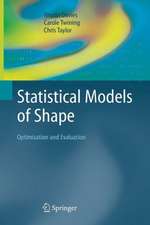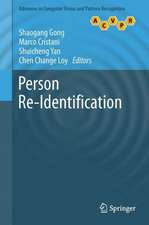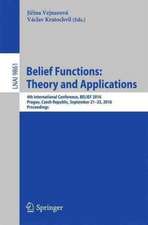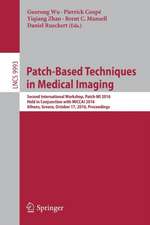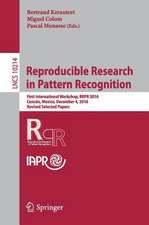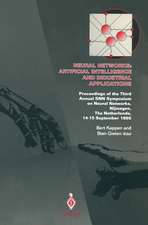ICANN ’93: Proceedings of the International Conference on Artificial Neural Networks Amsterdam, The Netherlands 13–16 September 1993
Editat de Stan Gielen, Bert Kappenen Limba Engleză Paperback – 23 sep 1993
Preț: 373.15 lei
Preț vechi: 466.44 lei
-20% Nou
Puncte Express: 560
Preț estimativ în valută:
71.40€ • 74.75$ • 59.08£
71.40€ • 74.75$ • 59.08£
Carte tipărită la comandă
Livrare economică 05-19 aprilie
Preluare comenzi: 021 569.72.76
Specificații
ISBN-13: 9783540198390
ISBN-10: 3540198393
Pagini: 1124
Ilustrații: XXVII, 1095 p. 79 illus.
Dimensiuni: 155 x 235 x 59 mm
Greutate: 1.54 kg
Ediția:1st Edition.
Editura: SPRINGER LONDON
Colecția Springer
Locul publicării:London, United Kingdom
ISBN-10: 3540198393
Pagini: 1124
Ilustrații: XXVII, 1095 p. 79 illus.
Dimensiuni: 155 x 235 x 59 mm
Greutate: 1.54 kg
Ediția:1st Edition.
Editura: SPRINGER LONDON
Colecția Springer
Locul publicării:London, United Kingdom
Public țintă
ResearchDescriere
This book contains the proceedings of the International Confer ence on Artificial Neural Networks which was held between September 13 and 16 in Amsterdam. It is the third in a series which started two years ago in Helsinki and which last year took place in Brighton. Thanks to the European Neural Network Society, ICANN has emerged as the leading conference on neural networks in Europe. Neural networks is a field of research which has enjoyed a rapid expansion and great popularity in both the academic and industrial research communities. The field is motivated by the commonly held belief that applications in the fields of artificial intelligence and robotics will benefit from a good understanding of the neural information processing properties that underlie human intelligence. Essential aspects of neural information processing are highly parallel execution of com putation, integration of memory and process, and robustness against fluctuations. It is believed that intelligent skills, such as perception, motion and cognition, can be easier realized in neuro-computers than in a conventional computing paradigm. This requires active research in neurobiology to extract com putational principles from experimental neurobiological find ings, in physics and mathematics to study the relation between architecture and function in neural networks, and in cognitive science to study higher brain functions, such as language and reasoning. Neural networks technology has already lead to practical methods that solve real problems in a wide area of industrial applications. The clusters on robotics and applications contain sessions on various sub-topics in these fields.
Cuprins
Plenary Contributions.- Dynamic coupling in cortical neural networks.- Keeping neural networks simple.- Principles from Neurobiology.- The autoassociative hypothesis places constraints on hippocampal organization.- Metastability of network attractor and dream sleep.- Somatosensory cortical maps: reorganization following postontogenetic plasticity—experiments and theory.- Adequate input for learning in attractor neural networks.- Neurobiological modelling and structured neural networks.- Model analysis of associative learning in the photoreceptor of marine mollusc, Hermissenda Crassicornis.- A neural network model for motor shapes learning and programming.- Learning through adaptive value: a model working in a variable environment.- Improving categorization with CALM maps.- A simple self-organizing neural network architecture for selective visual attention.- Detection of coincidences and generation of hypotheses — a proposal for an elementary cortical function.- DIVA: a self-organizing neural network model for motor equivalent speech production.- Adaptive non-uniform A/D conversion achieved with an unsupervised learning rule maximizing information-theoretic entropy.- Optimal topology-preservation using self-organising logical neural networks.- Incorporation of neurobiological aspects of Aplysia’s associative conditioning in neural networks for on-line pattern detection.- Description on the use of the autogenerative nodal memory model (ANM) as controlling element of an autonomously responsive system.- Human memory—neurocomputer (MeNeCo project): structure for reverbation of the information in N-peaked nets (in STMemory).- Neural representation of saccadic eye movements in monkey superior colliculus.- A self-organizing neural network for learning a body-centered invariant representation of 3-D target position.- Dynamic field approach to target selection in gaze control.- Differences in synaptic input and excitability between superficial and deep pyramidal cells in the cat sensorimotor cortex.- An adaptive sensory fusion approach for the superior colliculus.- A neural network model for spatial information representation.- A dynamical model for the generation of curved trajectories.- Functional organisation in the cerebellum.- Activation and contraction of a muscle.- Correlated neuronal activity and behaviour.- Map structure from pinwheel position.- Emergence of transient oscillations in an ensemble of neurons.- A distributed multicolumnar system for primary cortical analysis of real-world scenes.- Singularities in cortical orientation and direction maps: vortices, strings and bubbles.- A new model for spatial frequency and orientation tuning in the visual cortex based on delayed inputs from the retina.- Cascaded intracortical inhibition: modeling connection schemes on a large scale simulator.- Hidden assembly dynamics and correlated neuronal responses.- A model for latencies in the visual system.- A neural architecture for textured color image segmentation and recognition.- Activity-dependent modification of intrinsic neuronal properties.- Implications of and activity-dependent neunte outgrowth for developing neural networks.- PCA properties of interneurons.- Temporal distributed processing-TDP: a time-based processing scheme accounts for time dependent receptive fields and representational maps.- Stochastic specificity in neural interaction.- A computer simulation model of backwards feedback across synapse via arachidonic acid.- Study of a self-learning artificial neuron model.- Simulation study on calcium-activated dynamics of compartment dendrite model.- On the adaptive capabilities of pulse-coded cable neurons.- A local approximation of the cable equation for implementing a local interaction model.- Effect of glutamate uptake on the response dynamics of the retinal horizontal cell.- Robotics.- Neural networks for robot eye-hand coordination.- Unsupervised formation of feature detectors using residual inputs.- Geometry-driven diffusion: coupled diffusion maps as a model for excitatory and inhibitory behaviour in vision.- SPIN: learning and forgetting surface classifications with dynamic neural networks.- Motion parallax from catastrophies in scale-space.- Stability and convergence control in cooperative integration networks.- Towards a neural architecture for unified visual contrast and brightness perception.- Fuzzy Kohonen clustering networks for reducing search space in 3-D object recognition.- An active resistor mesh embedding cortical visual processing.- A fast BCS/FCS algorithm for image segmentation.- Neural architecture for robot planning.- From situations to actions: motion behavior learning by selforganization.- Application of Q-learning in robot grasping tasks.- I/O-stability for robot control with a global neural net inverse model in the feedback loop.- A self-organizing neural network for robot motion planning.- Evolved recurrent dynamical networks use noise.- The Bellmann Mapping Machine for nonlinear approximation in control policy space.- A real-time robot demonstration controlled by the BSP400 neurocomputer.- First results on stable adaptive robot control with RBF networks.- Fuzzy inference, radial basis functions, and control of flexible robotic manipulators.- A recurrent trajectory storage network with parceling of the workspace.- Node allocation and topographical encoding NATEnet for inverse kinematics of a 6-DOF robot arm.- Learning optimal control using neural networks.- A boolean net as an adaptive and universal robot control.- Transforming occupancy grids under robot motion.- Complex tasks and robots.- Cognitive Connectionism.- NN approaches to natural language: context and trends.- Integration of ANNs and dynamic concepts to an adaptive and self-organizing agent.- Learning fuzzy production rules for approximate reasoning in connectionist production systems.- A representational architecture for nonmonotonic inheritance structures.- Spectral timing and integration of multimodel systemic processes.- Net-to-rule transformation using penalty functions.- Teaching homing behaviour to a neural state machine.- Neural/iconic understanding of the visual world.- Connectionist “symbol” systems: cognition as the sum of analogy, exemplar manipulation and language.- Symbol-manipulation with attractor neural networks.- A consideration on visual strategy of fovea and saccadic movement from experimental results.- Iconic language representation in a recursive neural system.- Miniature language acquisition tasks using dynamic weightless systems.- Activity curvature: a new approach to perception.- An outline for a theory of the emotions.- Alpha-Beta TDNN implement “fuzzy” connectionist time alignment in speech recognition.- Continuous speech recognition predictive systems.- Handling context-dependencies in speech by LVQ.- An analytically transparent network for sequence recognition.- Conceptual clustering using a connectionist approach.- An extended Kohonen feature map for sentence recognition.- Neural nets that discuss: a general model of communication based on self-organizing maps.- Neural network and nearest neighbor comparison of speaker normalization methods for vowel recognition.- Speech recognition by hierarchical segment classification.- Visualization and classification of voice quality with the selforganizing map.- Weighted distance measure for speaker-independent digit recognition with hidden-control neural network.- Modulation-frequency encoding of speech with applications to neural speech recognizers.- Functional compositionality: a G.N.U. approach.- Physical and Mathematical Theory.- Competitive Hebbian learning rule forms perfectly topology preserving maps.- Approximating optimal information transmission using local Hebbian algorithms in a double feedback loop.- Time-varying neural networks for large tasks.- A “self-referential” weight matrix.- Neural network complexity reduction using adaptive polynomial activation functions.- FIELDNET, a dynamic network for pattern classification.- Reducing the ratio between learning complexity and number of time varying variables in fully recurrent nets.- Deletion of trained patterns by incremental learning in artificial neural network using Fahlman-Lebiere learning algorithm.- Cascade neural network developed for time series prediction.- On the information capacity of auto-associative RAM-based neural networks.- Modified CMAC neural network architectures for nonlinear dynamic system modeling.- Preliminary results on adaptively trained neural networks.- Networks for learning and differentiating an input-output mapping.- Design vs. training of neural machines.- Counterexample of Witsenhausen under set-bounded model of uncertainty and its neural net solver.- A modified learning algorithm for backpropagation network.- High-order Boltzmann machines for MAX-SAT and SAT.- EBP algorithm can work with hard limiters.- Stochastic neural networks.- A neurophysiologically motivated neural network model and its application to the superposition problem.- A symmetrical lateral inhibition network for PCA and feature decorrelation.- Minimizing the system error in feedforward neural networks with evolution strategy.- Prove of convergence of extended divide and conquer networks.- Monotonic incrementation of backpropagation networks.- A multi-layer extension of a Bayesian neural network.- YPROP: yet another accelerating technique for the back propagation.- Automatic construction of multilayer networks for non linear regression.- Generalization of a parametric learning rule.- Supervised learning for decorrelated Gaussian networks.- Associative memories that can form hypotheses: phase coded network architectures.- A formal link between multilayer perceptrons and a generalization of linear discriminant analysis.- Adaptive critic and probabilistic logic nets.- DEFAnet2—advancements of a deterministic function approximator.- Document retrieval and protein sequence matching using a neural network.- A fuzzy neural architecture for supervised learning and classification of temporal sequences.- Hierarchical reinforcement learning.- Connectivity maximization of layered neural networks for supervised learning.- The overlapped tessellaton: a supervised neural rule.- IABP: Interval Arithmetic Backpropagation.- Architecture of associative memory with reduced cross talk and its performance formulation.- Augmentation of generalisation in probabilistic logic nets.- Fuzzy expert networks.- Using Boltzmann Machines for probability estimation.- Brownian motion updating of multi-layered perceptrons.- Guaranteed convergence of learning in neural networks.- Activity-conserving dynamics for neural networks.- The lower bound of the capacity for a neural network with multiple hidden layers.- A method for finding the optimal number of learning samples and hidden units for function approximation with a feedforward network.- The N-2-N encoder: a matter of representation.- Optimizing the architecture of multi-layer perceptrons for onedimensional classification.- Neural networks and genetic algorithms: improving the fault tolerance capabilities.- Entropy of perceptrons.- Assessing generalization by 2-D receptive field visualization.- A fast training algorithm for feedforward neural networks.- Improvement of the convergence of the learning using the modified back-propagation method.- Parametrized self-organizing maps.- Population dynamics on the basis of vector quantization: a method for auto-association and classification.- Vector quantization with a growing and splitting elastic net.- Learning topology-preserving maps using self-supervised backpropagation.- A multiassociative memory for control.- Phase transitions in self-organized feature maps.- Unsupervised extraction of predictable abstract features.- Genetic algorithm with migration on topology conserving maps.- Analyzing Kohonen maps with geometry.- A comparison between classical unsupervised classifiers and ART3 neural networks.- A dynamic procedure for neural network design.- PCA in a network with full lateral connections.- Non-uniform cellular automata.- SUSOM—“Supervised” Self-Organizing Maps.- Synchrony in integrate-and-fire networks.- A neural network for motion detection.- Spikes or rates?—stationary, oscillatory, and spatio-temporal states in an associative network of spiking neurons.- Cooperative stochastic effects in globally coupled bistable elements.- Biologically inspired neural network for trajectory formation and obstacle avoidance.- Catastrophic phase transitions in exact ART networks.- Analysis of chaotic behaviour in dynamical systems using analog neural networks.- A dynamically generalising weightless neural element.- Vector quantization by neuro-dynamical system.- The effect of synaptic time constants on firing patterns in populations of spiking neurons.- Information processing by spatio-temporal chaotic networks.- Hysteresis phenomena and bifurcation of periodic solutions in a mathematical model of cortical dynamics.- Computing complexity of symmetric quadratic neural networks.- Topology learning solved by extended objects: a neural network model.- Higher order neural networks in a unified learning scheme.- On a simple hysteresis network.- Switching the vector field according to the input of an oscillatory neural network.- Processing of information encoded in coupled one-dimensional maps.- Feedback in single continuous neurons.- A neural network for decision making in dynamic environments.- Chaos in neural networks at nonlinear synapses.- Stability conditions for nonlinear continuous random neural networks.- Optimal classification with multilayer networks.- An attractor network model for the generation of event-related potentials using integrative synapses.- Novel Liapunov functions for additive neural networks.- Capacity and error correction ability of sparsely encoded associative memory with forgetting process.- Defining the attractor of a recurrent neural network by boolean expressions.- Using REDUCE for replica calculations.- Equilibrium statistical mechanics of non-symmetric neural networks.- Storage of words by coupling Hopfield nets.- Constraints on learning in dynamic synapses.- Recursive construction of neural networks with long periodic behavior.- Phase-space gardening in the binary-couplings memory network.- The relationship between choice of representation, network structure and performance in Harmony Theory networks.- On the power of linearly weighted neural networks.- Elimination of overtraining by a mutual information network.- Cascade correlation: an incremental tool for function approximation.- Bounds on the complexity of testing and loading neurons.- Principal hidden unit analysis with minimum entropy method.- Empirical criteria to compare the performance of neuro algorithms.- LS-backpropagation algorithm for training multilayer perceptrons.- Do backpropagation trained neural networks have normal weight distributions.- A constructive algorithm for binary mapping.- BOXES revisited.- Mathematical properties of multi-layer adaptive filters.- Weight zero enhancement in speech synthesis using neural networks.- Biological metaphors in designing modular artificial neural networks.- Learning and generalization controlled by contradiction.- Extraction of symbolic statements from synaptic weights.- A novel back propagation algorithm with optimal number of hidden units.- Two neural models for fast category learning—neural associative memories and the restricted Coulomb energy model.- Storage capacity results for decomposed structures of generalizing RAM nodes.- Applications.- Novelty detection and neural network validation.- Estimating material properties for process optimization.- Hybrid digital signal processing and neural networks for automated diagnostics using eddy current inspection.- Self-organizing neural network for diagnosis.- Limitations of adaptive critic control schemes.- Periodic disturbance rejection: a neural network approach.- Representation of real-valued functions by a three-layered artificial neural network with topologically ordered input and output units.- Prediction of reflectance values: towards the integration of neural and conventional colorimetry.- Neural network modeling and prediction of multivariate time series using predictive MDL principle.- Dynamics of a neural network-based financial market.- Evolving neurocontrollers for pole balancing.- Backpropagation vector quantization for satellite coverage plans optimization.- Sequential self-organization for the traveling salesman problem.- Invariant process control using neural networks.- Optimal control of dynamic systems using self-organising maps.- Monitoring a control system with a hybrid neural network architecture.- Paper web profile and analysis using neural networks.- Modelling of quality properties in paper drying with multilayer perceptron network.- Interpolation of stationary non-linear time series by an optimized neural network.- Two-sensor neural network modeling for fault detection.- Modelling the fed batch fermentation process using artificial neural networks.- Identification of car body steel by an optical on line system and a Kohonen’s self-organizing map.- Simulation of pulsed laser material processing controlled by an extended self-organizing Kohonen feature map.- Process modelling using artificial neural networks.- Real-time nuclear power plant monitoring with adaptively trained neural network.- Self organized feature maps for monitoring and knowledge acquisition of a chemical process.- Flow regime identification by a self-organising neural network.- Functional electrical stimulation with neural network controlled state feedback.- Artificial interacting agents for stock market experiments: the cross-target method.- Neural network training by parameter optimization approach.- Neural network analysis of the Hungarian party-state system.- Modelling time-varying industrial processes using MLP networks.- Lithofacies indentification from wireline logs—bringing neural networks to application.- Using selforganizing feature maps to classify EEG coherence maps.- Building an artificial retina for distance- and orientation-invariant pattern recognition.- MLP-RBF: a cooperative multi-modular neural network application in high-energy physics.- Operational cloud classifier based on the topological feature map.- Image segmentation using a self-organising logical neural network.- High-resolution classification of Papanicolauo smear cells using back-propagation neural networks.- Artificial neural networks detect subtle differences between anesthetics.- Pattern segmentation and feature linking as simultaneous processes in an associative network of spiking neurons.- Spatial topology distance for handprinted character recognition.- Identification of underwater sonar images using fuzzy-neural architecture FuNe I.- Fault detection in multivariate time series with a coding approach.- Practical implementation of a radial basis function network for handwritten digit recognition.- An efficient method of neural network application to recognizing of handwritten digits in zip codes.- The application of average gradient matrices for fingerprint classification using neural networks.- Neural architectures for motion tracking.- A multi-agent classifier using associative networks in parallel.- Handwritten alphabet and digit character recognition using skeleton pattern mapping with structural constraints.- Optimization of a signature verification system using neural networks.- Incremental case-based pattern classifier.- Cepstral blur identification by neural network for image restoration purpose.- Reduced pattern recognizing neural nets.- Digit recognition by the random neural network using supervised learning.- Detecting abnormalities in MRI images using the difference method.- Neural networks for the echographic diagnosis of diffuse liver diseases.- Neural networks and the travelling salesman problem.- Automatically structured neural networks for handwritten character and word recognition.- Tracking rain cells in radar images using multilayer neural networks.- Neural network analysis of plasma spectra.- Monitoring EEG signal with self-organizing map.- Invariant pattern recognition with recovery of transformation parameters.- Applying dynamic link matching to object recognition in real world images.- Performance of the backpropagation neural network for recognition of radio signals using time-domain features.- Conceptual fuzzy sets application to facial expression recognition using associative memory system.- Neocognitron with non-uniform receptive fields.- Hand-written character recognition by a structured self-growing neural network “CombNET-II”.- Segmentation of image sequences using self-organizing feature maps.- Combining neural-network and statistical methods in seismic firstarrival picking.- A study of neural network input data for ground cover identification in satellite images.- On generalization ability of cascaded neural net architecture.- Assessing the latency of peak Pa in auditory evoked potentials using neural networks.- A self-organizing network of alterable competitive layer for pattern cluster.- Prediction of secondary structures of proteins: comparison of neural networks (fuzzy ARTMAP) and statistical techniques.- Cognitive grammar and map digitization.- On-line learning with learning vector quantization: a case study of EEG classification.- Image sequence coding using a neural vector quantization.- Minimum distance pattern classifiers based on a new distance metric.- Knowledge extraction by self organising maps.- Application of the sensitivity algorithm in biological fields.- Challenge of ANN to microelectronics.- Implementation of million connections neural hardward with URAN-I.- Multiprocessor and memory architecture of the neurocomputer SYNAPSE-1.- COKOS: A Coprocessor for Kohonen’s Selforganizing map.- Hardware implementation of Kohonen’s feature map by scalar and SIMD-array processors.- A nonlinear electronic layer for distributed neural nets.- How to find a near optimal mapping of neural networks onto message passing multicomputers.- 20 million patterns per second VLSI neural network pattern classifier.- High-density analog-EEPROM based neural network.- A simple training law suitable for on-chip learning.- Simulation of neural networks and genetic algorithms in a distributed computing environment using NeuroGraph.- A parallel implementation of the back-propagation of errors learning algorithm on a SIMD parallel computer.- CONVIS, a distributed environment for control and visualization of neural network simulation programs.- Mapping of some neural network algorithms to a general purpose parallel neurocomputer.- Architecture of low cost, large scale neural networks.- A generalized recurrent neural network for matrix inversion.- On the realization of back-propagation on a transputer based system.- Self-organisation of large feature maps using local computations: analysis and VLSI integration.- NEUROCOBOL: a COBOL-like neural network simulation language based on the layer macro definition.- Encapsulated objects for neural network simulation.- A harmony theory network solution to the N-Queens problem.- Author Index.



